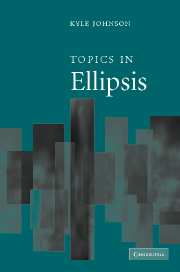Book contents
- Frontmatter
- Contents
- 1 Introduction
- 2 VP Ellipsis and constraints on interpretation
- 3 Direct compositionality and variable-free semantics: the case of Antecedent Contained Deletion
- 4 The view of QR from ellipsis
- 5 Argument Contained Ellipsis
- 6 Variable island repair under ellipsis
- 7 On binding scope and ellipsis scope
- 8 The silent content of bound variable pronouns
- 9 A step-by-step guide to ellipsis resolution
- 10 Shared constituents and Linearization
- Notes
- References
- Index
3 - Direct compositionality and variable-free semantics: the case of Antecedent Contained Deletion
Published online by Cambridge University Press: 22 September 2009
- Frontmatter
- Contents
- 1 Introduction
- 2 VP Ellipsis and constraints on interpretation
- 3 Direct compositionality and variable-free semantics: the case of Antecedent Contained Deletion
- 4 The view of QR from ellipsis
- 5 Argument Contained Ellipsis
- 6 Variable island repair under ellipsis
- 7 On binding scope and ellipsis scope
- 8 The silent content of bound variable pronouns
- 9 A step-by-step guide to ellipsis resolution
- 10 Shared constituents and Linearization
- Notes
- References
- Index
Summary
Since at least as early as Sag (1976), the phenomenon of Antecedent Contained Deletion (hereafter, ACD) has generally been taken as strong evidence for a level of Logical Form or some other abstract syntactic representation mediating between the surface syntax and the model-theoretic interpretation of a sentence. In particular, it is often taken as a settled matter that ACD shows that at least sometimes a quantified NP in object position is not interpreted “in situ.” Rather, the semantic composition of a sentence like John read every book involves a level of representation in which the object is just a simple pronoun or trace interpreted as a variable. The purpose of this paper is to show that this received wisdom is mistaken. ACD is perfectly compatible with the view that quantified NPs are interpreted “in situ” – i.e. the meaning of read directly combines with the meaning of every book to give a VP meaning.
What is at stake here is more important than just the question of how to interpret quantified NPs in object position: my main concern is to provide support for two broader hypotheses. The first is the hypothesis of direct compositionality: the syntactic combinatory operations “build” (i.e. define as well-formed) surface syntactic expressions while the semantics works in tandem to supply a model-theoretic interpretation for each expression as it is “built” in the syntax.
- Type
- Chapter
- Information
- Topics in Ellipsis , pp. 30 - 68Publisher: Cambridge University PressPrint publication year: 2008
- 2
- Cited by



